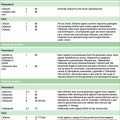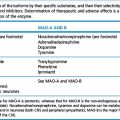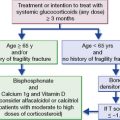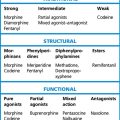Chapter 33 Intestines
Diarrhoea
Fluid and electrolyte treatment
Oral rehydration salts (ORSs)
The World Health Organization/UNICEF-recommended formulation is:
This provides sodium 90 mmol/L, potassium 20 mmol/L, chloride 80 mmol/L, citrate 10 mmol/L, glucose 111 mmol/L (total osmolarity 311 mmol/L). Several other formulations exist, some with less sodium (see national formularies).
Antidiarrhoeal drugs
Drugs that directly increase the viscosity of gut contents
Kaolin and chalk are adsorbent powders. Their therapeutic efficacy is marginal as is shown by the fact that they are often combined with an opioid; they should not be used routinely. Bulk forming agents such as ispaghula, methylcellulose and sterculia1 (see above) are useful for diarrhoea in diverticular disease, and for reducing the fluidity of faeces in patients with ileostomy and colostomy.
Secretory diarrhoea due to vasoactive peptides
Octreotide, a synthetic somatostatin analogue (see p. 549), inhibits the release of peptides that mediate certain alimentary secretions, and may be used to relieve diarrhoea due to neuroendocrine tumours such as carcinoids and VIPomas (tumours that produce VIP).
Bile acid malabsorption (BAM)
If no treatable underlying cause of BAM is identified then a bile acid absorption resin such as colesevelam, colestipol or colestyramine may be given. These are awkward drugs to take, due to taste, consistency and to the fact that they bind numerous other drugs. They must therefore be given at least 1 hour before or several hours after the administration of other drugs. Bile acid sequestrants are also used as lipid-lowering drugs (see Ch. 26).
Constipation
Constipation means different things to different people, and is difficult to define formally. Generally it refers to infrequent, hard to pass bowel motions. Rome III criteria2define constipation as 2 + of the following over 12 weeks: < 3 stools per week, straining > 1/4 of the time, passage of hard stools, incomplete evacuation, sensation of anorectal blockage.
Drugs to stimulate colonic motility
Stimulant laxatives
Sodium picosulfate
is similar and is also used to evacuate the bowel for investigative procedures and surgery.
The anthraquinone group
of laxatives includes senna, danthron, rhubarb3 and aloes. In the small intestine soluble anthraquinone derivates are liberated and absorbed. These are excreted into the colon and act there, along with those that have escaped absorption, probably after being chemically changed by bacterial action.
Osmotic laxatives
Lactulose
is a synthetic disaccharide. Taken orally, it is unaffected by small intestinal disaccharidases, is not absorbed and thus acts as an osmotic laxative. Tolerance may develop. Lactulose is also used in the treatment of hepatic encephalopathy (see Ch. 34).
Excessive use of stimulant and/or osmotic laxatives may lead to severe water and electrolyte depletion, even to hypokalaemic paralysis and renal failure, especially in the elderly4 or those with diabetes or pre-existing renal impairment. Where bowel cleansing is necessary in these patients (e.g. before surgery or endoscopy), a less aggressive laxative and/or bowel preparation under medical supervision (with electrolyte and fluid balance monitoring) should be considered.
Inflammatory bowel disease (IBD)
The inflammatory bowel diseases ulcerative colitis (UC) and Crohn’s disease6 are chronic relapsing/remitting diseases of the GI tract characterised by intestinal mucosal inflammation. The pathogenesis of inflammatory bowel disease (IBD) remains incompletely understood. IBD can be thought of as an inappropriate immunological response to non-pathogenic luminal antigens. This can be either an overenthusiastic damaging pro-inflammatory response to an innocuous stimulus or an underwhelming protective anti-inflammatory response which fails to keep an appropriate inflammatory reaction in check. A combination of genetic predisposition and environmental factors produces either Crohn’s disease, which can affect any part of the GI tract, or UC, which is confined to the colon. Classically, UC is thought to result from dysregulation of the Th1/cell-mediated immune pathway while Crohn’s results from disorders of Th2/humoral immunity, but this is almost certainly an oversimplification.
5-ASA and corticosteroids have been the mainstay of treatment of IBD for decades; indeed, the use of corticosteroids in UC has a particular place in the history of the randomised controlled clinical trial.7
Drugs to induce remission in UC
Aminosalicylates
Sulfasalazine
has been used to treat rheumatoid arthritis since the 1930s (see p. 252). It was subsequently noted to have activity against ulcerative colitis. It consists of two compounds, sulfapyridine and 5-aminosalicylic acid, joined by an azo bond. Sulfasalazine is poorly absorbed from the small intestine, and colonic bacteria split the azo bond to release the component parts. Sulfapyridine is well absorbed, acetylated in the liver and excreted in the urine; it has no therapeutic action in colitis and functions solely to deliver 5-ASA to the colon.
Drugs to induce remission in Crohn’s disease
Maintenance of remission in IBD
Methotrexate,
a folic acid antagonist, can be helpful in controlling relapses of Crohn’s disease unresponsive to corticosteroid or azathioprine. It has also been used with benefit in ulcerative colitis. Its short- and long-term use are limited by a wide profile of adverse effects including bone marrow suppression and pulmonary and hepatic fibrosis (see p. 248). It is given once weekly, with folic acid supplements on the days on which it is not taken. It is severely teratogenic and is contraindicated in both men and women trying to conceive.
Irritable bowel syndrome (IBS)
This condition affects 20% of the population and is the commonest reason for referral to a gastroenterologist. It is manifested by a variety of gastrointestinal symptoms including disordered bowel habit (constipation, diarrhoea, or both), abdominal pain and bloating. Upper gastrointestinal symptoms manifest as non-ulcer dyspepsia (see Ch. 32). All of these symptoms occur in the absence of demonstrable pathology in the gastrointestinal tract, although patients with IBS often have abnormalities of gut motility. Another feature of the condition is visceral hypersensitivity; patients with IBS have lower thresholds for pain from colonic distension induced by inflating balloons placed in the bowel. A proportion of patients develop their IBS symptoms after an episode of gastroenteritis and, in many, emotional stress is an important precipitating factor. Associated psychopathology, with anxiety and sometimes depression, is common.
Gastroparesis
This complication of longstanding diabetes results from diabetic neuropathy affecting the enteric nervous system. Reduced bowel motility results in bloating, nausea, vomiting, impaired gastric emptying and abdominal pain. Prokinetics such as domperidone and metoclopramide are advocated (see Ch. 32); also erythromycin (250–500 mg four times daily) through a motilin agonist activity.8 It therefore has synergistic activity when used with domperidone or metoclopramide.
Abraham C., Cho J.G. Inflammatory bowel disease. N. Engl. J. Med.. 2009;361:2066–2078.
Al-Abri S.S., Beeching N.J., Nye F.J. Traveller’s diarrhoea. Lancet Infect. Dis.. 2005;5:349–360.
Ananthakrishnan A.N. Clostridium difficile infection: epidemiology, risk factors and management. National Reviews of Gastroenterology and Hepatology. 2011;8:17–26.
Baumgart D.C., Sandborn W.J. Inflammatory bowel disease: clinical aspects and established and evolving therapies. Lancet. 2007;369:1641–1657.
Camilleri M., Tack J.F. Current medical treatments of dyspepsia and irritable bowel syndrome. Gastroenterol. Clin. North Am.. 2010;39:481–493.
Kelsall B. Interleukin-10 in inflammatory bowel disease. N. Engl. J. Med.. 2009;361:2091–2093.
Madoff R.D. Pharmacologic therapy for anal fissure. N. Engl. J. Med.. 1998;338:257–259.
Mowat C., Cole A., Windsor A., et al. IBD Section of the British Society of Gastroenterology. Guidelines for the management of inflammatory bowel disease in adults. Gut. 2011;60:571–607.
National Institute for Health and Clinical Excellence. Irritable Bowel Syndrome in Adults. Diagnosis and Management of Irritable Bowel Syndrome in Primary Care. London: NICE; 2008.
Pardi D.S., Kelly C.P. Microscopic colitis. Gastroenterology. 2011;140:1155–1165.
Quartero A.O., Meineche-Schmidt V., Muris J., et al. Bulking agents, antispasmodic and antidepressant medication for the treatment of irritable bowel syndrome. Cochrane Database Syst. Rev. 2, 2005. CD003460
Venuto C., Butler M., Ashley E.D., Brown J. Alternative therapies for Clostridium difficile infections. Pharmacotherapy. 2010;30:1266–1278.
World Health Organization. Diarrhoea Treatment Guidelines. Including New Recommendations for the Use of ORS and Zinc Supplementation. Geneva: World Health Organisation; 2005.
1 Named after Sterculinus, a god of Ancient Rome, who presided over manuring of agricultural land.
2 The Rome consensus series of statements standardise the diagnostic criteria for irritable bowel syndrome, defining, in part, what constitutes abnormal stool frequency and consistency. Rome III criteria appear in: Longstreth G F, Thompson W G, Chey W D et al 2006 Functional bowel disorders. Gastroenterology 130:1480–1491.
3 In the late 18th century Britain made approaches to trade with China that were met with indifference; it seems that the mandarins held the belief that the British feared death from constipation if deprived of rhubarb (Rheum palmatum), one of China’s exports.
4 The Roman Emperor Nero (AD 37–68) murdered his severely constipated aunt by ordering the doctors to give her ‘a laxative of fatal strength’. He ‘seized her property before she was quite dead and tore up the will so that nothing could escape him’ (Suetonius, trans. R Graves).
5 In the 19th century ‘young men proceeding to Africa’ were advised to take pills named Livingstone’s Rousers, consisting of rhubarb, jalap, calomel and quinine (British Medical Journal 1964; 2:1583).
6 Crohn and his colleagues Oppenheimer and Ginzberg, all from the Mount Sinai Hospital in New York, published a case series describing a necrotising granulomatous inflammatory disease of the terminal ileum in 1932. Others may well have described and published similar observations years before, but Crohn’s alphabetical and clinical precedence means that his surname alone is now associated with the disease he initially termed ‘terminal ileitis’. He quickly renamed it ‘regional ileitis’, in part to avoid any overly morbid connotations. Crohn B B, Ginzburg L, Oppenheimer G D 1932 Regional ileitis: a pathologic and clinical entity. Journal of the American Medical Association 99:1323–1328.
7 Clinical investigators have long been aware of the need to randomise treatments and minimise observer bias. (See: Gluud C 2011 Danish contribution to the evaluation of serum therapy for diphtheria in the 1890 s. Journal of the Royal Society of Medicine 104:219–222.) But in their clinical trial of ulcerative colitis, Truelove and Witts expressed the issues with clarity when they randomised patients to receive either cortisone or placebo, stating: ‘It was judged that if the physician proceeded on the assumption that every patient might be receiving potent cortisone, and if he also had the right to stop treatment at any time he considered it likely to be doing harm, such a blind trial was justified because of the greater value of its results’ (Truelove S C, Witts L J 1954 Cortisone in ulcerative colitis; preliminary report on a therapeutic trial. British Medical Journal 2:375–837.)
8 Motilin is a pro-peristaltic hormone secreted by neuroendocrine cells in the proximal small bowel. Its physiology remains poorly understood.






